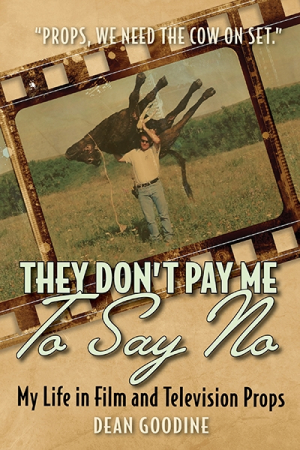They Don't Pay Me To Say No
My Life in Film and Television Props
They Don’t Pay Me to Say No captures the human moments of making a movie or television show via a fascinating series of anecdotes.
Dean Goodine’s They Don’t Pay Me to Say No, a memoir about working as a film and television prop master, is a delightful tour behind the scenes of building an imaginary world, one object at a time.
“We are the silent people on set who make a scene come alive,” Goodine writes in his opening chapter. “My time in props has been exhilarating, terrifying, and humbling, but it has also been hilarious.” With a keen eye for excitement, suspense, and humor, Goodine crafts memorable scenes about finding and wrangling everything from cows to antique Colt 45s. The lively prose makes the small details of working with props and colleagues come into a sharp, intriguing focus.
The short, chronological chapters move at a rapid pace, imitating the frenetic tempo established when hundreds (even thousands) of workers strive to meet a production schedule, and then a last-minute script change means that they must re-calibrate. Whether describing work on a small budget film or an Oscar contender like Clint Eastwood’s Unforgiven, Goodine maintains the same intensity. It’s only when he’s describing post-production moments that he slows down enough to facilitate continuity between the chapters, with some welcome reflection and worthwhile wisdom about achieving a balance between one’s work and personal lives.
A good-humored tone pervades the book, which delivers plenty of praise for everyone involved, from fellow workers in the pre-production trenches to bigwig movie stars and directors. Humorous asides are frequent. They are sometimes self-deprecating, but never snide. When embarrassment overcomes Goodine after he’s asked to hold a blanket for actors beginning a skinny-dipping scene, he demurs, saying, “We’re in Canada. Our winters are cold, and we don’t do nudity well.”
In all of the action and hilarity of the book, two serious themes emerge: of work-life balance, and about safety on set. Lives continue to be lost due to poor safety protocols around guns and other dangerous props, and Goodine is a strong advocate for putting an air-tight process in place to protect all workers, including the actors.
They Don’t Pay Me to Say No both captures the human moments of making a movie or television show and covers important decades during the light-speed evolution of digital technology, including the advent of CGI. The book’s last gift is a narrative glossary explaining the roles of other film departments, including costuming and electronics––a final bit of insider information that rounds out Goodine’s goal to pass on the awe and excitement of being a part of film production.
A fascinating series of anecdotes about the people and props that make everyone’s favorite movies and television shows come to life, They Don’t Pay Me to Say No is wholesome entertainment at its best.
Reviewed by
Michele Sharpe
Disclosure: This article is not an endorsement, but a review. The publisher of this book provided free copies of the book and paid a small fee to have their book reviewed by a professional reviewer. Foreword Reviews and Clarion Reviews make no guarantee that the publisher will receive a positive review. Foreword Magazine, Inc. is disclosing this in accordance with the Federal Trade Commission’s 16 CFR, Part 255.

